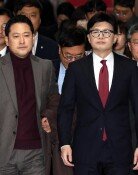Sustaining Recovery Momentum
The year-on-year growth rate of leading economic indicators was 11.3 percent in January this year, down from 11.6 percent in December last year. Leading indicators for economic activities three to six months ahead are calculated based on the trends of 10 indicators the previous year, such as the ratio of jobseekers to job openings, the inventory cycle and consumer expectation indexes, and the main stock index KOSPI. The governments fiscal support has driven economic recovery in Korea. After growing for 12 straight months in January, however, Koreas leading economic indicators stopped growing due to a fall in fiscal support.
Month-on-month growth range of leading economic indicators kept decreasing from two percentage points in July last year to two-tenths of a percentage point in December last year. So many experts predicted such growth would begin decreasing early this year. On the other hand, others said the leading indicators will not fall, citing stable business indexes as the reason. Korea, however, has an uncertain economic forecast due to external factors. The U.S. announced it would end its economic stimulus package last month. China is expected to change its pump-priming policies to strengthen management of restructuring and inflation at the National Peoples Congress from tomorrow. Accordingly, the Korean government needs to better manage its economic landscape.
Koreas coincident composite index, reflecting economic sentiment perceived by businesses and current economic conditions, has increased. Given the base effect that resulted from extremely bad economic conditions last year, however, it is premature to release rosy prospects. The majority of experts predict economic recovery will falter by June. The working class feels the benefits of economic recovery last. So policies are needed to prevent economic polarization from worsening at a time when the social safety net is not functioning well. Korea should not follow the model of Japan, a country whose economy has suffered from a widening income gap as economic vitality has weakened since the 2000s.
Depending solely on government fiscal support to boost the Korean economy is also not desirable. Seoul changed its fiscal policy from expansionary to active last year. The government also has little room to spend more money to stimulate recovery. Given the growing threat of a fiscal deficit, the top priority should be efficiency of government spending.
The government must now hand over its role of leading economic recovery to the private sector. Korean companies had bank savings of 215 trillion won (187 billion U.S. dollars) late last year, up 21 percent year-on-year, but are hesitant to invest. If this hesitation continues, they cannot contribute to creating more jobs or increasing personal income, thus causing the economy to decline. For its part, the government should check investment conditions to encourage more corporate investment. Cities and provinces also need to compete against each other to proactively resolve the difficulties faced by companies.







